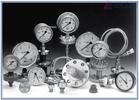 With the economic development and social progress, the pattern of users' demand for instrumentation has also undergone great changes. The main change is the provision of a single product to product + method + service, that is, a solution. Taking the environmental protection industry as an example, it focuses on manual sampling and experimental analysis to the direction of automation, intelligentization, and networked monitoring; it develops from narrower areas of monitoring to omni-directional monitoring and development, and combines simple position loop orientation with remote sensing and environmental testing. development of.
With the economic development and social progress, the pattern of users' demand for instrumentation has also undergone great changes. The main change is the provision of a single product to product + method + service, that is, a solution. Taking the environmental protection industry as an example, it focuses on manual sampling and experimental analysis to the direction of automation, intelligentization, and networked monitoring; it develops from narrower areas of monitoring to omni-directional monitoring and development, and combines simple position loop orientation with remote sensing and environmental testing. development of. Research shows that environmental monitoring instruments will develop in the direction of high-tech combined with physics, chemistry, electronics, optoelectronics, biology, etc.; and develop toward high-quality, multi-functional, automated, integrated, systematic, and intelligent.
At the same time, the user's application requirements for instrumentation have gradually expanded, shifting from single-field or specific-level requirements to increasingly widespread and widespread demand development. Taking gas detection instruments as an example, with the promotion of the market and policies, the improvement of relevant laws of the country, and the improvement of people's safety awareness, the scope of industrial applications for gas detection instruments is increasing and continues to expand, such as gas and petrochemicals. , metallurgy, coal, environmental protection, aviation, military, anti-terrorism, indoor air quality testing, road traffic safety testing, gas leaks and CO detection.
Today, the instrumentation industry has two distinct features, namely system integration and integration, providing industry solutions. Experts pointed out that the domestic instrumentation industry must first develop the manufacturing service industry to realize the transformation of products from solutions. For example, the overall boiler combustion solution should be based on the premise of safety protection, high-efficiency control as the main line, energy-saving and emission-reduction purposes, and green development, including various on-site inspection instruments, DCS control systems, safety combustion monitoring systems, and smoke gas detection. Monitoring system, ignition system, vibration system and equipment management system.
Secondly, it fully grasped the opportunities in the combat-ready emerging industries, and focused on upgrading the R&D and application of emerging sensors such as wireless autonomous network technologies and MEMS. Taking the Internet of Things as an example, the Internet of Things has become a strategic emerging industry. In 2015, the market size will reach 750 billion yuan. The entire industrial chain has a huge demand for sensors for its core components. According to CCID's forecast, the sensor market size in 2015 will reach RMB350 billion. In 2010, the market for sensor sales will reach 90.5 billion yuan.
Again, vigorously develop equipment automation and upgrade the overall level of equipment manufacturing. Instruments and meters are the key to improving the level of equipment manufacturing, and they are coordinated with the equipment manufacturing industry. Domestic instrument companies must closely focus on auto equipment, new energy equipment, energy-saving and environmental protection equipment, and other development equipment automation.
The low-carbon economy, emerging industry's policy stimulus in the country and the huge market have become the hot spots for current capital flows, and have a close relationship with the instrumentation industry. The "three highs and three lows" of instrumentation, ie the characteristics and advantages of high technology, high input, high output, low energy consumption, low material consumption, and low pollution, will drive up the demand for instrumentation under the development of low carbon economy and emerging industries.
Motor End Cover,Washing Motor End Cover,Aluminum Engine Cover,Washing Machine Motor Cover
Ningbo Sunlee Electrical Technology Co. , Ltd. , https://www.nbsunlee.com